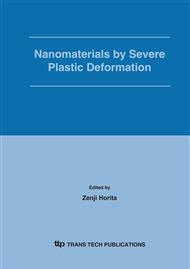p.227
p.233
p.239
p.245
p.251
p.259
p.267
p.275
p.281
Spatial Uniformity of the Rate of Grain Coarsening in a Submicron Al-Sc Alloy Produced by Severe Plastic Deformation
Abstract:
The uniformity of grain coarsening throughout the microstructure of a submicron grained particle-containing aluminium alloy has been investigated using high resolution EBSD. The alloy was processed by equal channel angular pressing (ECAP) and low temperature ageing to generate ~0.8 m diameter grain structure containing a relatively uniform dispersion of nanosized Al3Sc particles. While the initial processing route generated a uniform grain size distribution, the distribution of grain orientations was rather inhomogeneous with certain regions of microstructure containing colonies of grains consisting predominantly of either HAGBs or LAGBs. It was found that, despite the difference in grain boundary character between these regions, the fine particles produced by pre-ageing promote uniform coarsening throughout the microstructure despite the marked differences in boundary character between these regions. An analytical model is outlined which predicts the uniformity of grain coarsening in particle-containing alloys despite the presence of orientation gradients in the microstructure.
Info:
Periodical:
Pages:
251-258
Citation:
Online since:
January 2006
Authors:
Price:
Сopyright:
© 2006 Trans Tech Publications Ltd. All Rights Reserved
Share:
Citation:


